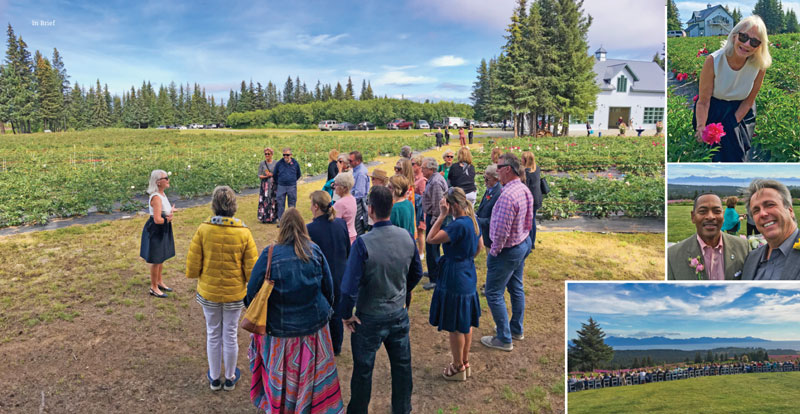9/1/2019
Dinner with Alaska’s Peonies
Chris Beytes

The most far-flung of the Certified American-Grown “Field to Vase” dinners held this year boasted its most breathtaking setting: Joslyn Peonies, a hilltop home and farm in Homer, Alaska, overlooking Kachemak Bay and the Kenai mountains about four hours southwest of Anchorage on the Kenai Peninsula. The August 3 event was hosted by “Farmer” Betty Joslyn and her husband, Tony, 45-year Alaskan “sourdoughs” (those who live in Alaska year-round).
GrowerTalks had the pleasure of being part of the event, which included a farm tour, reception and seafood dinner (sponsored in part by the Alaska Seafood Marketing Institute, so you know the oysters and salmon were fresh). On the long, long table that seated more than 100 guests were 2,000 peonies arranged by Christi Lopez of Bergerons Flowers & Events.
Also in attendance? Just a few important people, such as Senator Lisa Murkowski, Homer Mayor Ken Castner and National Agricultural Statistics Service (NASS) Administrator Hubert Hamer, top man at the USDA agency (I sat next to him at dinner). Quite a do for little Homer!
Joslyn Peonies is one of about 130 or so peony farms in the state, an industry that’s only a dozen or so years old. It came about when Patricia Holloway, a University of Alaska horticulturist, noted that the state’s peonies bloomed weeks or even months later than those in other parts of the world, giving Alaska an edge in late peonies for summer weddings and events. Now Alaska peonies are becoming known world-wide.
Betty is pretty new to the industry, having planted her first peonies in 2012 and getting her first harvest about three years ago. She farms 6,000 of the perennials, tending them carefully to get the most flowers possible during the frantic three-week harvest. Like most farmers, she sells via a cooperative that helps market the product.
It’s not all easy sailing, however. The 2019 season was a tough one for peonies, with drought and a heat wave bringing the crop in way early, with fewer high-quality blooms. We were told that Vermont peonies came in later than Alaska’s.
David Russell, PhD and his wife, Jill, were across the table from us. They’re both professors from Ohio who fell in love with Alaska, eventually moving there to teach at the university. A colleague was growing peonies successfully and convinced them to give them a try. After some research, they bought an old hay farm and Boreal Peonies was born. They do both production and—because they’re scientists—research. David is also president of the Alaska Peony Growers Association, so I asked him about the outlook for Alaska’s young peony industry.
“I believe we can become world players,” he said. But he added that climate change and technology could make it a challenge. As demonstrated this season, it doesn’t take much heat to bring the crop in early, erasing their advantage. Plus, the Dutch are apparently working on storage techniques for peony flowers that would allow them to hold them for later sales.
Still, one advantage is Alaska itself. David said he did a sale of peonies to a major UK grocery chain specifically because they come from Alaska. GT
Pictured top right: Betty with the variety Felix Supreme. • Hubert Hamer of USDA NASS. He’s the fellow responsible for collecting data on our industry and hundreds of other agricultural commodities.